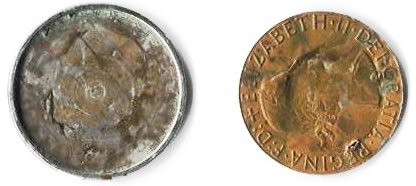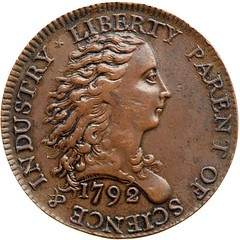
PREV ARTICLE
NEXT ARTICLE
FULL ISSUE
PREV FULL ISSUE
IS THE HALF DOLLAR WITH A SECRET COMPARTMENT AN ELECTROTYPE?David Klinger writes: I think the hollow 1942 half dollar Mr. Gonzalez wrote about is an electrotype. Instead of filling the shells with lead, which is the usual procedure, this one was filled with a British large penny of Elizabeth II. The left image in the picture is a view of the inside of the electrotype shell.

I asked David if he thought the piece was a contemporary counterfeit - a way for someone to pass a penny off as a half dollar. He writes: I think it is possible, but not likely, that it was made as a counterfeit. It may have been someone experimenting with electrotypes who did not have the ability to melt lead to fill the shell, and instead just found a coin which would fit. Just guessing. Some electrotypes are filled with tin or plaster - I never saw one filled with another coin. I 've played around with plaster casts and electrotypes of coins. It is not easy, and it takes a lot of time for a novice. Electrotypes which are left empty often get bent or otherwise damaged. I've seen several in that state in the British Museum collection. The basic problem with electrotypes is that for best detail the shell has to be thin; but, for durability the shell should be thick. Of course, I could be completely wrong and it could be a hollowed out real coin. Should be able to tell just by looking at it. From the pictures it looks like an electrotype to me. Notice the solder residue on the coin, and on the inside of the shell.
This is an image of an electrotype of a rare Birch cent which shows a professional grade electrotype. They can be made with any metal which can be plated.
Makes sense, but why would someone make an electrotype of such a common coin in the first place? For practice? It does seem more likely than counterfeiting. Most half dollar counterfeits I've heard of are solid and made of lead. What do readers think?
-Editor
To read the earlier E-Sylum article, see:
NOTES FROM E-SYLUM READERS: SEPTEMBER 11, 2011: A Half Dollar With A Secret Compartment
(www.coinbooks.org/esylum_v14n38a19.html)
The Numismatic Bibliomania Society is a non-profit organization promoting numismatic literature. See our web site at coinbooks.org. To submit items for publication in The E-Sylum, write to the Editor at this address: whomren@gmail.com To subscribe go to: https://my.binhost.com/lists/listinfo/esylum All Rights Reserved. NBS Home Page Contact the NBS webmaster 
|
